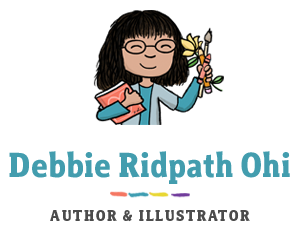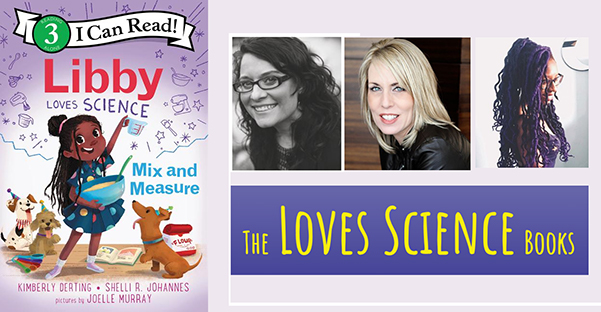
“My daughter said she wasn’t going to science camp because ‘science was for boys.'”
Shelli R. Johannes had never written a picture book when she heard her daughter’s stance on science, but it sparked the idea that she, with co-author and friend Kimberly Derting, would turn into the Loves Science series.
Libby Loves Science: Mix and Measure is the latest instalment in the series and shows young readers that science is for everyone. Libby is throwing a puppy party and wants to bake cupcakes – but she is missing an important ingredient! With the help of her friend Rosa and little brother, Libby uses science to solve the problem. Libby Loves Science: Mix and Measure releases on January 5th, 2021 from HarperCollins/Greenwillow and is available for preorder.
In addition to co-authoring the six Loves Science books, Shelli R. Johannes writes critically-acclaimed teen novels and thrillers. You can find her on her website, Twitter, and Instagram.
Kimberly Derting is a co-author of the Loves Science series. She is also the author of the award-winning young adult The Body Finder series, The Pledge trilogy, and The Taking trilogy. The Body Finder and The Pledge were selections for YALSA Best Fiction for Young Adults. You can find her on her website, blog, Twitter, and Instagram.
Illustrator Joelle Murray is an artist, character designer, animator, and dancer. She is currently illustrating in-app early learning books on the Khan Academy Kids app. You can find Joelle on her website, Instagram, and Twitter.
Q for Shelli: Libby Loves Science: Mix and Measure is the latest title in the Loves Science series – congratulations! I understand that this book aims to teach some basics of chemistry to children. As a child, how enthusiastic about science were you?
Shelli: Kim and I have always talked about how much we both love science. Even when I was little, I always loved science! I had pet sea monkeys, made mud pies (chemistry), loved animals (zoology), and spent a lot of time at the ocean because I lived by a beach town (oceanology). I have done a lot of conservation work with animals, and my husband has a PhD in Topography, so when we had kids, especially a girl, we both felt science was important. And I’m going to take a risk and say I think MOST kids love some kind of science as well, whether it be animals, rocks, flowers, baking, space, or gardening. Kids just tend to think of science as always being taught in school and forget that science is all around them. Everywhere. It’s almost impossible not to love at least one science.
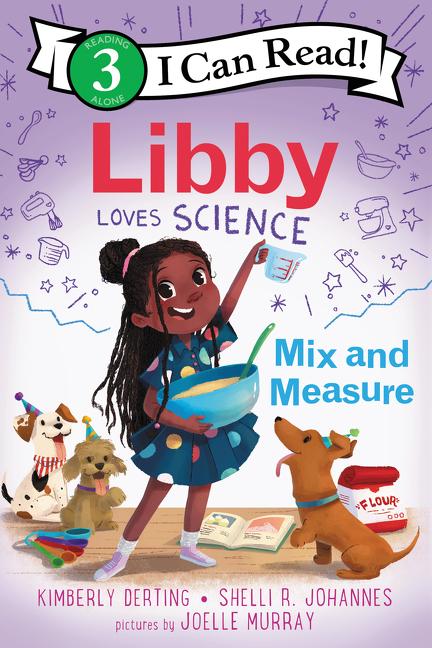
Q for Shelli: You co-wrote this book and the Loves Science series with Kimberly Derting. Would you walk me through how the collaboration process works?
Shelli: First, Kim and I are best friends and have been critique partners of each other’s thrillers for over 10 years. We talk almost everyday… mostly about NOTHING!
As far as our writing process, Kim and I focus on STEM books together. So we usually brainstorm an idea first over Skype, until we get a sense of the overall story. Usually, we jot down a high level story in a bullet form. Then, we move it into a picture book template of 16 spreads/32 pages. Once we have a solid strawman of the story, we talk through the story in more detail over Skype or FaceTime and start building it out on a shared screen. I usually type as we talk and try to throw in too many jokes, while she keeps us on track, reading it for flow and overall story. My goal tends to be about including bad jokes, while Kim’s goal is definitely more about getting down a solid story. We obviously spend a lot of time on Skype. 🙂 Once we have a solid draft, we email the draft back and forth, each making our own edits in tracked changes. Then once we have a good solid manuscript, both of our agents (who are with the same agency!) get to review it and tear it up until we get it right. It’s a 4-person posse.
If Kim and I ever disagree, we just try to work through it together. In the beginning, when we discussed writing together, we made a pact before we ever started to put our friendship first. We always make sure that we both agreed with and love every decision we make together. Our motto has kind of become, “Us over Me.” That goes for any creative or business decision we have to make as a team.
We always choose “US” first, over our agents, and over our editors. Our friendship comes first over everything else. If one of us feels strongly about one thing, then we agree to do something else until we are both on the same page. We have always heard horror stories about some co-authors fighting and losing their friendship – so this was the safest way we could feel good about working together. We know we can always count on each other. No matter what.
Q for Kimberly: Would you speak a bit about the collaboration process with Shelli?
Kimberly: When Shelli first approached me about the idea of co-writing together, I was skeptical – writing is such a personal process, and collaborating at that level had the potential to go wrong on so many levels. But we had been friends for years and were already critiquing each other’s work, so there was a built-in level of trust. We had a long discussion about what co-writing would look like for us and how we would handle differences in opinion, because we were bound to have them!
Surprisingly, it’s been pretty smooth sailing. We’ve learned to respect, and even embrace, our differences. Shelli has a sillier sense of humor than I do. She’s great on first drafts and will take the book in directions I might not have considered. I’m better at detail and steering us back on course. It’s great synergy. Plus, we love the process and crack ourselves up, so working together never really feels like work.
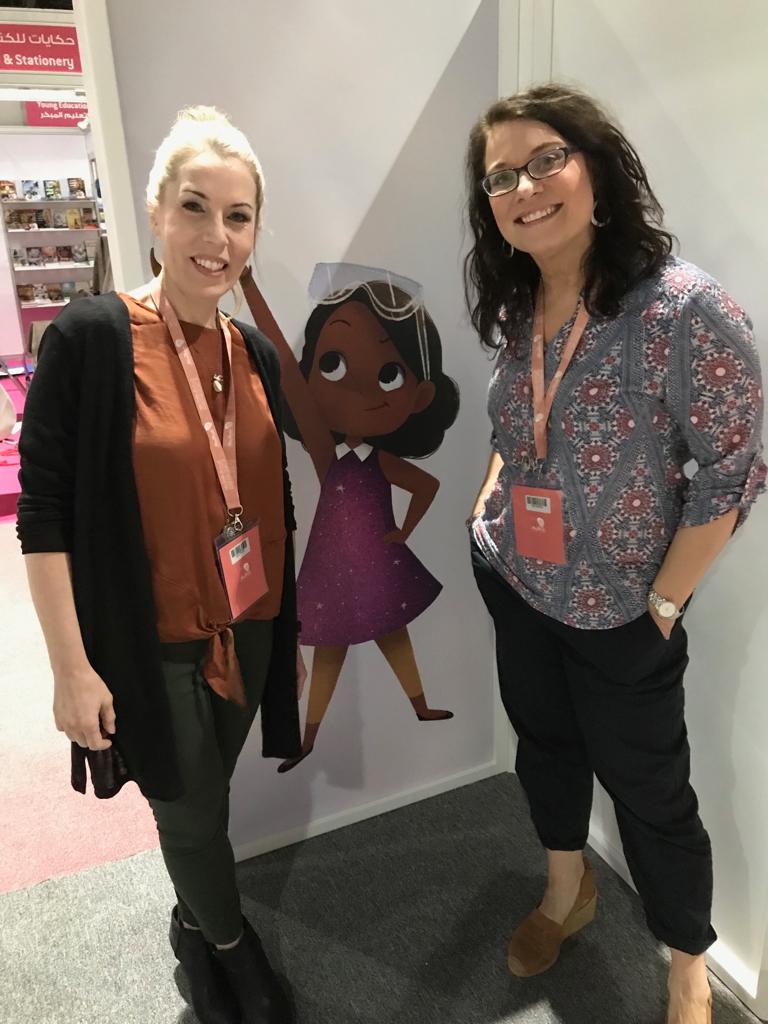
Q for Joelle: Would you tell me a bit about your illustration process for Libby Loves Science: Mix and Measure?
Joelle: I wanted to make sure the baking and measuring came across as fun and dynamic in the illustrations, even though the majority of the book takes place in one location: the kitchen. I felt the character poses and expressions were really going to sell that and were important to get right. It’s also my favorite part of the process! Libby, Leo, and Rosa clearly love baking and being together, so I wanted their joy to jump off of the pages!
So I kept that in mind when I began the illustrations and made sure to integrate it even more as I went along. The rest of the process is pretty much how I go about illustrating most things, be it a book, or a one-off illustration. I read through it first, and then I did very quick sketches of what I saw in my head as I read the story. Generally, when I’m reading something, I can picture the shots, angles, poses, and expressions I want, so I try my best to translate that in the drawings. After I did the quick initial sketches, I went in and made the sketches a bit more solid, to give me a nice, clear base for the colours. I made sure to choose fun colours, and colours reminiscent of desserts, to tie back into the baking aspect, and the fun aspect that I mentioned earlier. The colour takes the longest, but is very rewarding once it’s complete!
Q for Shelli: How does writing a STEM-focused series differ from a standalone book? Do you find your writing process is different?
Shelli: My process doesn’t really differ for my own picture books, except that I don’t ever disagree with myself (unless it’s my agent). 🙂 Well actually, that’s not true. I do argue with myself, but that’s a whole different story. But in general, it’s just Me, Myself, and I on my own projects.
But I develop my picture books the same way because it’s worked so well for Kim and me. I get an idea, come up with the story, bullet it out in a PB template, and develop it from there. Of course my agent has to love it too.
I actually do have two standalone picture books coming in 2021: Theo Thesaurus (The Dinosaur Who Loved Big Words) (Philomel, May 18th, 2021) and Shine Like a Unicorn (How to Love Your YOU-nique Self) (Harper Children’s, September, 2021)
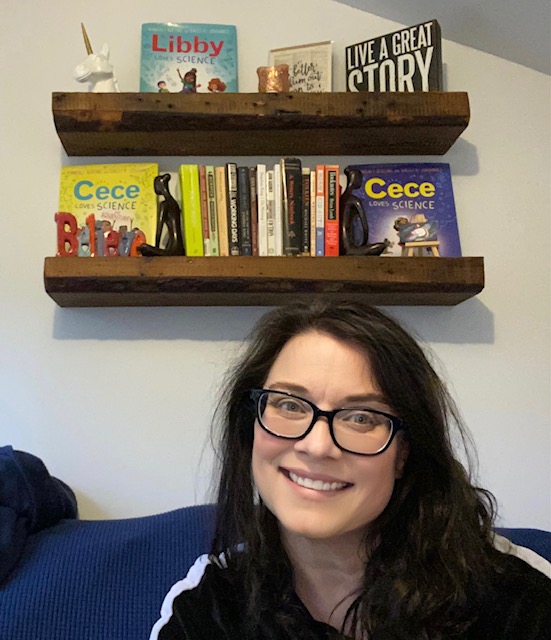
Q for Shelli: What was your journey to getting the contract for the Loves Science series? Do you have any advice for writers hoping to break into STEM-focused books for young readers?
Shelli: Kim and I had never written picture books, nor did we ever think we would. We are thriller writers at heart. But one day, my daughter said she wasn’t going to science camp because “science was for boys.” That disturbed me as a mom. I suddenly got an idea to do a Fancy Nancy for Science. I called Kim and told/complained/whined to her about my daughter and about the book idea. Oddly enough, her daughter had said something very similar about science, so we agreed it was an issue. Since Kim had studied biology, we eventually decided to write the book together, and the Loves Science series was born. The book went through many iterations with agents and the editorial process. We got rejections but eventually got a PREempt from our editor (Virginia Duncan) at Greenwillow. And strangely, her daughter had said the same thing about science! So I guess in the very end, it came down to the stars aligning at the right time, in the right way, with the right editor/house.
Q for Shelli: What advice do you have for new writers (particularly those who want to write for an elementary school audience)?
Shelli: When you are picking a topic for picture books, be sure to keep the 5-8 year old in mind. Is it something they deal with (i.e. baby sister, new pet, playdates, crayons)? You have to write the issues for them that connect with their age group experience. I think sometimes, as authors, we forget who we are writing for. Also, I think the sweet spot in fiction picture books that are character-driven is somewhere between 400-800 words. If your picture book is 1500 words (excluding nonfiction), then make sure it’s tight enough. I also want to say that writing picture books is much harder than I thought it would be. It’s not easy to tell a story that keeps the attention of a kid in just 600 words.
Q for Joelle: Do you have any advice for young illustrators?
Joelle: My advice for young illustrators is to always keep drawing! Every day you draw, paint, or sketch, you get better, and it really does show after a time. Always carry a sketchbook with you and draw or record what you see and what inspires you. Also, draw and paint from life as much as possible. Having a grasp on real life anatomy, color, and light, for example, makes your illustrations much more authentic and rich. There also may be some days where you feel burnt out and don’t feel like doing any art at all, and that’s okay too! Sometimes your mind just needs to rest, and that is also a valid part of the creative process.
Q for Shelli: What’s one thing you hope a young reader takes away from Libby Loves Science: Mix and Measure?
Shelli: Now you can read and do science – together! Also that science is everywhere. You don’t have to wait for an experiment in school – you can find your own experiment at home (making rainbow pancakes) or outside (making a rock garden) and bring in your imagination. It’s fun!
Q for Shelli: Finally, what kind of cupcakes would you bake for your own dogs, if you threw them a puppy party?
Shelli: I would say beef or chicken, but that’s gross. So maybe sweet potatoes? Though my dogs would eat almost anything, unless it’s vegetables or fruit, and then they would never touch it. Kind of like me. 🙂
To continue the series, we have a third character, Vivi Loves Science, coming in Summer 2021, which explores the fun topic of oceanology and investigates the ecosystems of tide pools.

Sara Truuvert completed her MLitt in Creative Writing at the University of St Andrews. She also holds a Certificate in Creative Writing from the Humber School for Writers and a BA in English, Drama, and the History and Philosophy of Science from the University of Toronto. Her work has appeared in the Literary Review of Canada among other publications.

